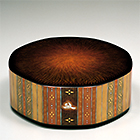Japanese Archaeology and Special Exhibition (Heiseikan) Thematic Exhibition Room
January 15, 2014 (Wed) - February 23, 2014 (Sun)
166 artists have been designated as living national treasures in the field of decorative arts to this day. Currently, 56 persons are active as artists on the front line of Japanese decorative arts and training heirs to the traditional arts and techniques.
In this chapter, 53 artists from the six categories of ceramics, textiles, urushi work, metalwork, wood and bamboo work, and dolls are highlighted.
Living National Treasures produce works using traditional techniques they inherited as well as those they devised to hand down the future generations, to add new pages to the history of Japanese decorative arts.
This section sheds light on how they achieved their current creation styles, what they are thinking, and what they are intending to create anew; their thoughts on the tradition and what should be preserved today are shown together with the Living National Treasures' own comments.
Here are the Living National Treasures of today as the starting point of Japanese decorative arts of the future.

